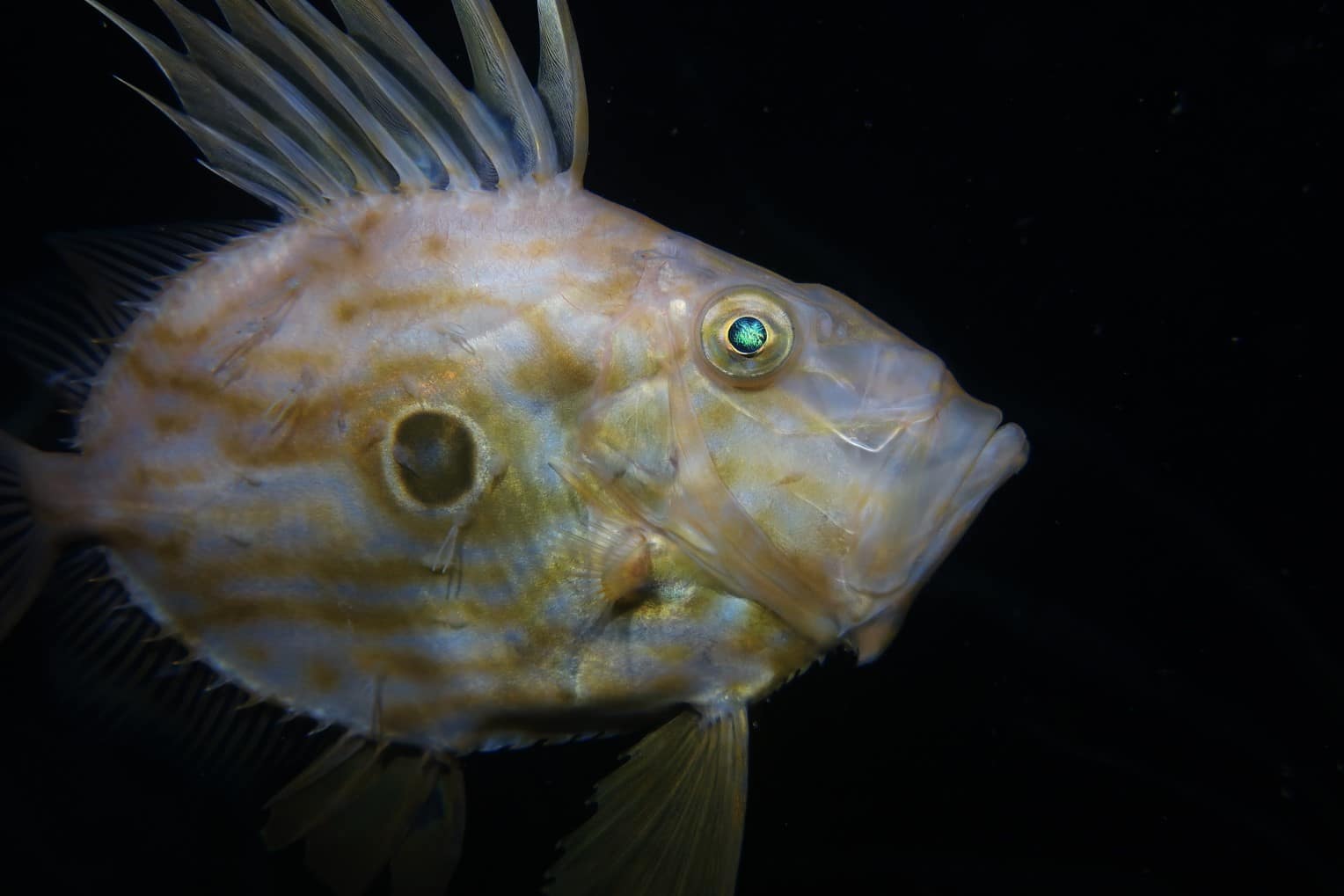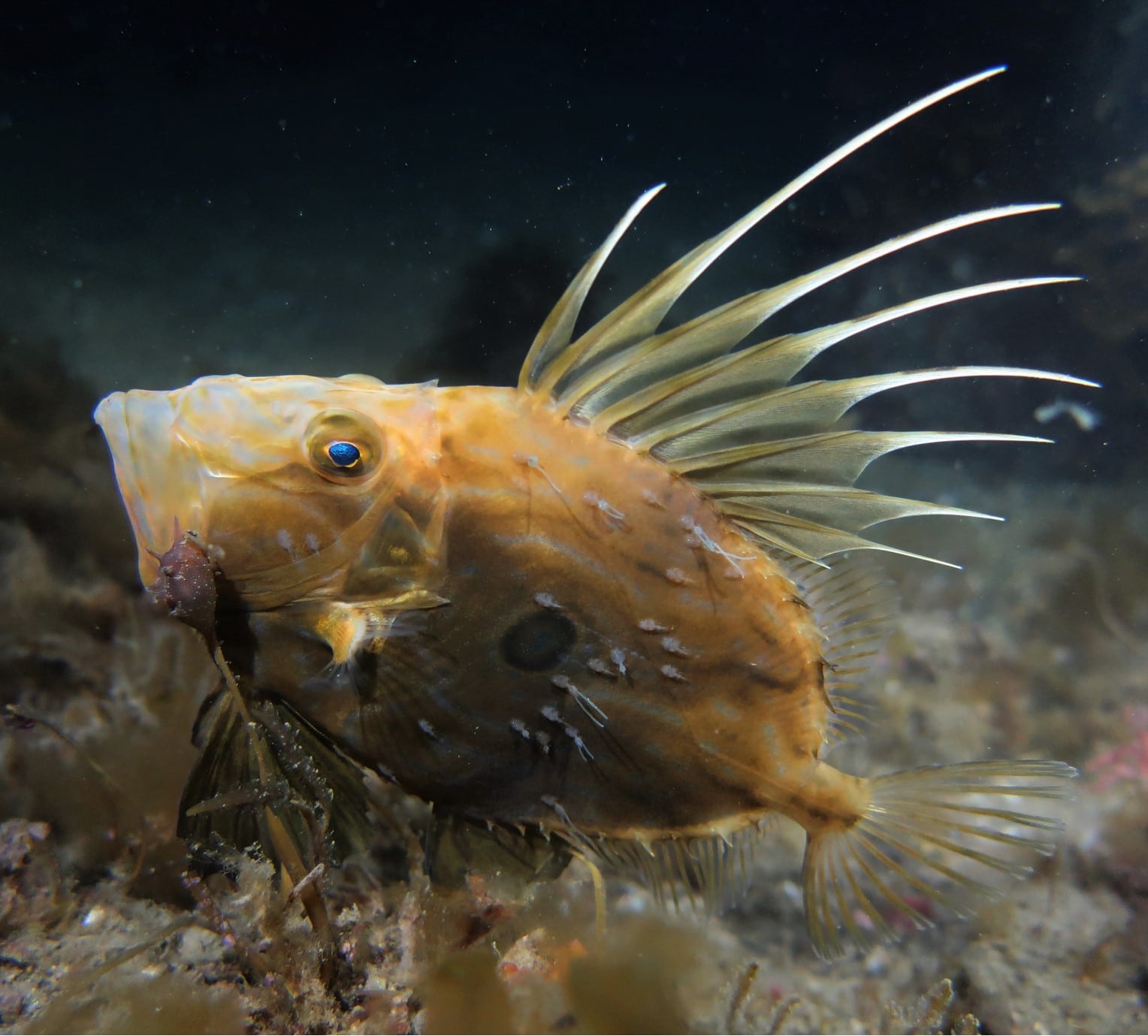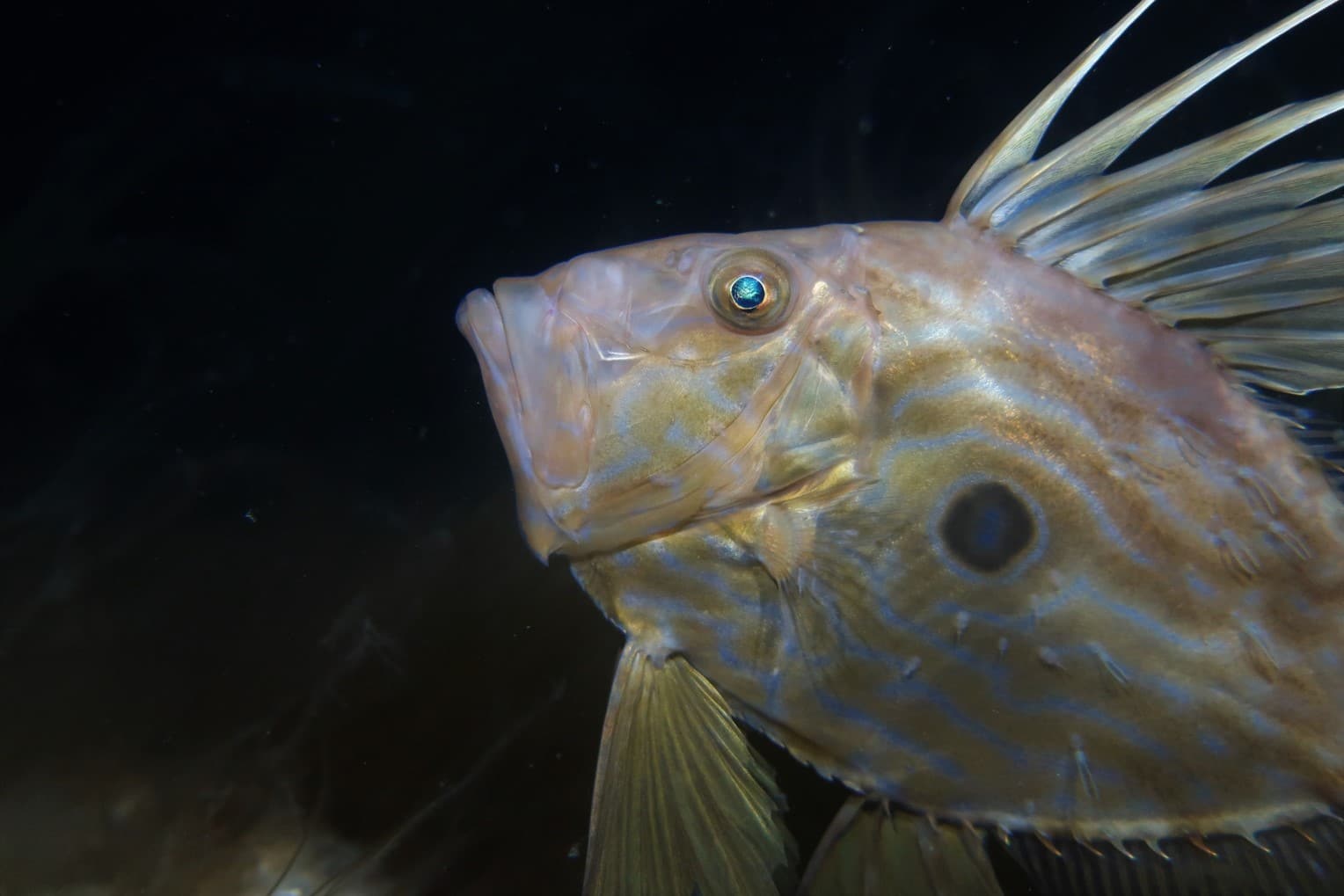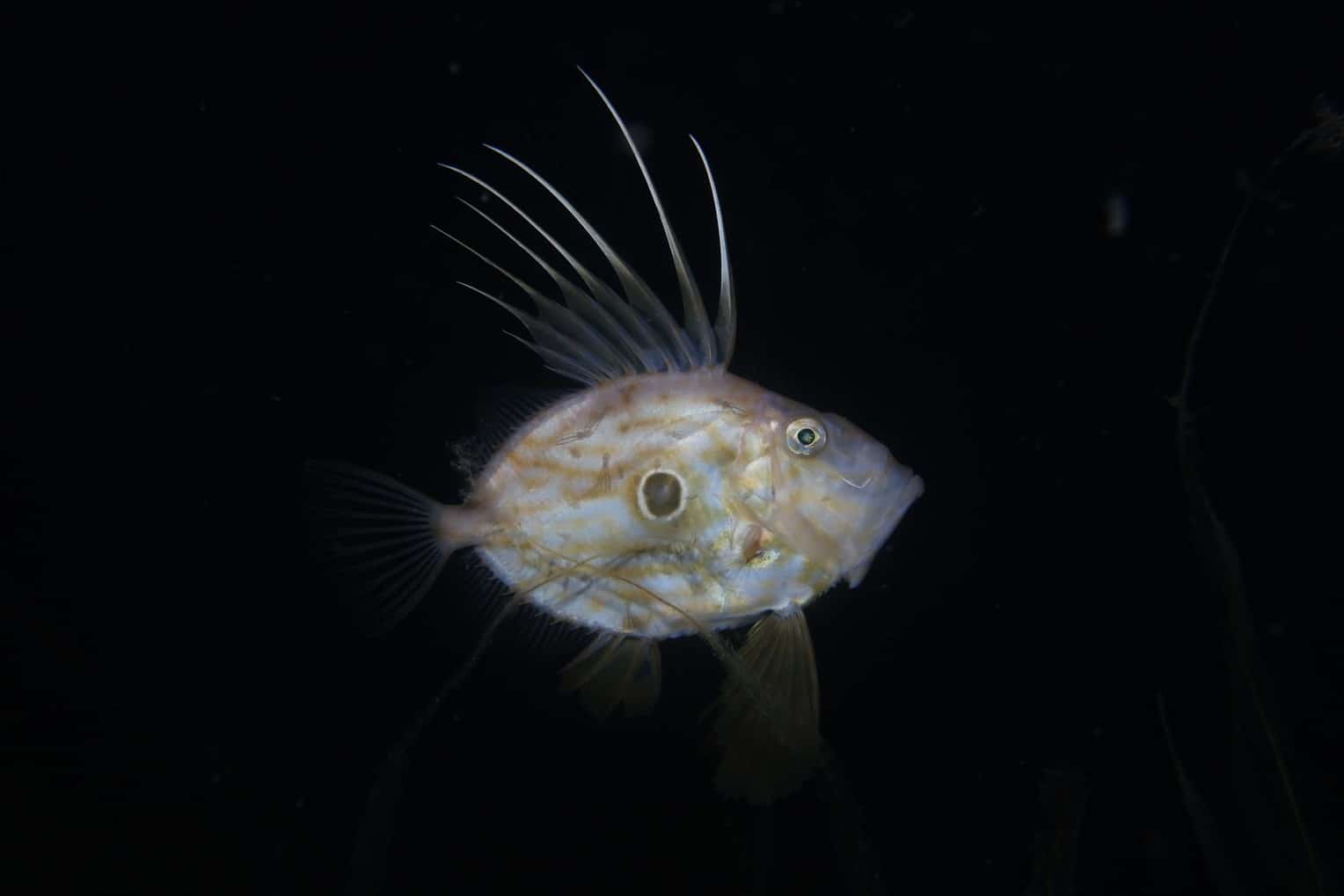Marine Life & Conservation
Diving with British Marine Life: The John Dory

Part 1 of a new series by our latest blogger Georgie Bull…
A few years ago, I attended a work experience placement at the London Aquarium. During a school session, the staff members gave the children a group of 20 photo cards and asked them to choose which ones they thought showed native species. The cards pictured the likes of corkwing wrasse, orca, basking sharks, cod, whiting, mackerel, and vibrant nudibranchs. Of these, colourful species were seldom selected. At the end of the activity, it was revealed that all the cards showed permanent or seasonal UK residents, which was met with shock from both the pupils and staff.
From this experience, and many more like it, I’ve come to realise just how underappreciated British marine life is.
Over the next six blogs, I will explore just a handful of the charismatic species encountered in the South West of England. I aim to introduce each species, describing my encounters with them before highlighting any relevant literature. There is still so much we don’t know about the species living on our doorstep.
In the build up to my first night dive at Chesil Cove last year, sighting reports circulated that john dory (Zeus faber) were seemingly everywhere. This species had been on my ‘to see’ list for quite some time so any likelihood of seeing one filled me with excitement. Halfway through the dive I noticed a faint, but frantic undulation centred around what looked like a large grumpy dinner plate. It was indeed a john dory. This individual was so full of expression that I found it hard not to fixate myself for the duration of the dive! This was the start of what became a frequent occurrence throughout the season.
Profile
As well as their false eyespot, elongate fins, and disc like body, john dory demonstrate distinctive behaviour in the water. Their movement is relatively slow, though their soft anal and dorsal fins (positioned behind their spined counterparts) move frantically to alter their position in the water. While small, their mouth is capable of rapid extension to draw in prey, and they’ll manoeuvre their bodies into all sorts of strange positions in the water to do so.
Zeus faber are often associated with warm water, but their distribution conflicts this idea, with their Northern range extending as far as Norway!
John dory are categorised as data deficient by the IUCN. The IUCN ranks species based on their population trends, and they are particularly famous for their ‘Red List’ which categorises endangered species. Sometimes insufficient information is available, and the organism is regarded as data deficient. As this is the case for the john dory, questions arise about how their population is coping with its value to the fishing industry.
Literature
It’s true that anglers and divers value john dory, but scientists have been finding out more about the species in recent years. One of their most distinctive features is the false eyespot. These spots are found in a variety of organisms from butterflies to lizards and are thought to divert predator attacks to less essential parts of the body (e.g. the tail) which may offer increased chance of escape. The role of eyespots in nature is understudied, but lab experiments in 2011 and 2013 showed that predators were inclined to attack eyespots spots more so than other areas of the body. This provided evidence in favour of eyespots acting as attack diversions.
On a different note, sound in the marine environment is receiving increased attention recently. Iconic footage captured by the BBC for Blue Planet 2 of reef noise, or hot topics like noise pollution from boat traffic are taking centre stage. But sound in the marine environment is used by individuals to communicate in a variety of different ways. John dory create sounds with sonic muscles that surround their swim bladder. Until 2018, this sound had only been recorded in air. A study recorded the species using baited remote underwater video (BRUV) footage and found that individuals would make the sound when predators were near. This caused predators to flee, suggesting the sound could serve as a territorial defence mechanism. As with all species, there are still many aspects to the life of john dory that we are only just beginning to understand.
References:
- https://www.iucnredlist.org/species/198769/42390771
- https://www.marlin.ac.uk/species/detail/1542
- https://royalsocietypublishing.org/doi/full/10.1098/rspb.2013.1458
- https://link.springer.com/article/10.1007/s00265-011-1173-7
- https://journals.plos.org/plosone/article?id=10.1371/journal.pone.0204647
Hear more from Georgie here: https://georgiebullphotography.home.blog/
Marine Life & Conservation
Paul Watson Released as Denmark Blocks Japan’s Extradition Bid

Renowned anti-whaling activist Paul Watson has been released from custody in Greenland after spending five months in detention. Denmark’s Justice Ministry rejected Japan’s request for his extradition, citing insufficient guarantees that his time already served in custody would be credited against any potential sentence.
The 74-year-old Canadian-American was arrested on July 21 in Nuuk, Greenland’s capital, when his ship docked to refuel. His arrest was based on a 2012 Japanese warrant related to a 2010 encounter in Antarctic waters. Japan alleged Watson obstructed operations and caused damage to a whaling research ship during efforts to disrupt illegal whaling. Watson has consistently denied these claims, maintaining his commitment to marine conservation.
Denmark, which oversees extradition matters for Greenland, concluded that while the legal conditions for extradition were met, the lack of assurances from Japan regarding time-served credit made extradition untenable.
In a video shared by his foundation, Watson expressed gratitude and relief, saying, “After five months, it’s good to be out… and good to know they’re not sending me to Japan.” He added that the most difficult part of his time in custody was being separated from his two young sons.
Watson is a pioneering figure in marine conservation, known for founding the Captain Paul Watson Foundation in 2022 after decades of activism with the Sea Shepherd Conservation Society. His bold efforts to defend marine life have earned him widespread support, including from celebrities and conservationists. His work has also been featured in the acclaimed reality TV series Whale Wars.
Watson’s lawyer, Jonas Christoffersen, praised the decision, stating, “We are happy and relieved that Paul Watson is now free.” He added that Watson is eager to reunite with his family and continue his vital work.
The arrest occurred while Watson’s vessel, the M/Y John Paul DeJoria, was en route to the North Pacific with a team of 26 volunteers to intercept a Japanese whaling ship. His foundation described the arrest as politically motivated and emphasized that Watson’s actions were focused on ending illegal whaling practices.
Japan resumed commercial whaling in 2019 after leaving the International Whaling Commission, asserting that whale meat is a cultural tradition. Conservationists, however, continue to challenge these practices, highlighting their impact on marine ecosystems.
Despite the challenges, Watson remains steadfast in his mission to protect marine life and bring attention to whaling practices. His dedication to ocean conservation has made him a globally respected advocate for the environment.
Marine Life & Conservation
12 Days of Zero-Waste Fish-mas

This holiday period, the Marine Conservation Society, the UK’s leading ocean membership charity, invites you to make some simple changes to eating fish this Christmas to help our seas.
Dr Kenneth Bodles, Head of Fisheries and Aquaculture at the Marine Conservation Society, said, “During the festive season, our consumption increases, but so does waste. Sustainability isn’t just about where food comes from – it’s also about how you use it. By reducing waste and making the most out of your seafood, you’re not only taking steps to be more ocean-friendly, but can also help to cut costs during what is often one of the most expensive times of the year”.
The Marine Conservation Society has compiled twelve tips on how to consume seafood sustainably with zero-waste this Christmas:
Buy whole fish instead of fillets
Instead of fillets, consider buying whole fish such as salmon, hake, or lemon sole. By adopting a “nose to tail” approach with cooking, whole-baked fish not only feeds a crowd, but also helps to minimise waste and maximise sustainability by using up every part of the animal, including bones, skin, and fat.
Make fish stock
Leftover fish bones or shells can be put to good use by boiling them to make a nourishing fish stock or bisque. This can be frozen and preserved for later use and makes for a flavourful base in a soup.
Make your own fish pâté
Avoid waste by turning leftover fish, such as smoked mackerel or salmon, into a delicious pâté by blending with cream cheese and lemon. Perfect when paired with crackers.
The sustainability of salmon and mackerel varies depending on where and how it is caught or farmed. For more information on green-rated options, check the charity’s Good Fish Guide.
Buy frozen
By purchasing seafood that is frozen or vacuum-packed, this helps to reduce waste by extending the shelf life of your food.
Fish pie
If you’re wondering what to do with leftover cooked fish, why not opt for a classic fish pie with mashed potatoes, leeks, and a cheesy sauce? A sure crowd pleaser on Boxing Day.
Use the head
Don’t forget the fish head! The meat is incredibly tender and flavourful. The charity recommends a cod’s head curry or recreating Fallow’s renowned cod’s head in siracha butter.
By stretching your ingredients further, not only is this a more sustainable way to enjoy seafood, but also cost-effective by repurposing leftovers and cooking creatively.
Boxing Day brunch
Mix leftover kippers or smoked salmon with scrambled eggs for a tasty, zero-waste, Boxing Day brunch.
For best choice, make sure you buy kippers, or herring, from the North Sea and the North Irish Sea.
Zero-waste storage
A top tip from the Marine Conservation Society to avoid waste is freezing fish offcuts to save for future use.
Crisp up the skin
Even leftover fish skin can be turned into a quick savoury snack by crisping it up in an air fryer with a little olive oil and salt.
Anchovies two ways
Leftover anchovies can either be blended with butter to make a delicious anchovy butter or tossed into pasta for a hit of umami flavour.
The charity recommends opting for anchovies caught in the Bay of Biscay for best choice.
Fishcakes
For an easy, zero-waste meal, leftover seafood trimmings can be mixed with mash and fried in breadcrumbs to make fishcakes.
Pickled mussels
Try pickling mussels in 1:1 vinegar and water, with a dash of sugar for a sustainable, zero-waste snack that can be enjoyed well beyond the festive season.
Mussels farmed in the UK are a seafood superhero. Grown using low-impact methods and harvested by hand, they get all the food they need from the sea around them. This makes them one of the most sustainable, ocean-friendly, and cost-effective seafood options.
Players of People’s Postcode Lottery have raised £6.6M towards the Marine Conservation Society’s vital work in making seafood more sustainable.
Laura Chow, Head of Charities at People’s Postcode Lottery, said: “Fish is a festive favourite for many, but making sustainable choices when it comes to how we buy and eat seafood makes all the difference for our ocean. Support from players of People’s Postcode Lottery has helped the Marine Conservation Society further its sustainable seafood work, so that we can all enjoy healthier, better protected seas.”
The Marine Conservation Society encourages you to make sustainable seafood choices a year-round habit, not just for Christmas. To check how sustainable the seafood on your plate is, you can visit the charity’s Good Fish Guide. The Guide helps consumers and businesses identify the most sustainable seafood using a simple traffic light system, based on where and how species are caught or farmed. Green is the best choice, amber means improvements are needed, and red indicates fish to avoid buying.
Zero-waste gift idea
Why not embrace a zero-waste Christmas by gifting a membership to support marine conservation? It’s a meaningful, low-waste gift that helps protect our ocean for generations to come. Memberships start from as little as £5 a month – the price of a sandwich and drink from your local coffee shop.
Find the latest sustainable seafood advice for wild-caught and farmed seafood on the Good Fish Guide, downloadable to your phone from www.mcsuk.org/goodfishguide.
-

 News2 months ago
News2 months agoIconic SS United States to become the World’s Largest Artificial Reef
-

 News3 months ago
News3 months agoBook Review – 52 Assignments: Underwater Photography
-

 Gear News3 months ago
Gear News3 months agoDYNAMICNORD – New German diving brand enters the British market
-

 News3 months ago
News3 months agoExploring Cenote El Pit: A Diver’s Dream
-

 Gear News3 months ago
Gear News3 months agoTry BARE drysuits (and maybe even win one!) this Friday with Sea & Sea at North West Dive Fest
-

 Marine Life & Conservation3 months ago
Marine Life & Conservation3 months agoBook Review: Coral Triangle Cameos
-

 Blogs2 months ago
Blogs2 months agoDive the Egyptian Red Sea this Autumn with Regaldive
-

 News3 months ago
News3 months ago2024 Ocean Art Underwater Photo Competition Announced


















